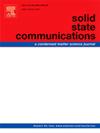Electronic, magneto-optic and band alignments of MnO2/AlN and MnO2/SiC topological vdW hetrostructures: A DFT study
IF 2.4
4区 物理与天体物理
Q3 PHYSICS, CONDENSED MATTER
引用次数: 0
Abstract
Based on density functional theory (DFT), structural properties, elastic stability, electronic stability, magneto-optic Kerr effect (MOKE) and band offsets were determined by applying GGA and HSE06 approximations, with van der Waals (vdW) switch of MnO2/AlN and MnO2/SiC heterostructures (HSs) have been investigated. The result of energy calculations and elastic parameters show the stability of these two HSs. MnO2/AlN vdWHSs and MnO2/SiC vdWHSs have an indirect band gap characterized by type-I band alignment, which can specifically locate photogenerated charge carriers. Also, the investigation of magneto-optical parameters of these vdWHSs shows the change of and angles up to about 0.9° for MnO2/AlN vdWHSs. The ferromagnetic property of MnO2 layer has broken the time-reversal symmetry and enabled MOKE in these two vdWHS. More interestingly, the study of the band structure diagram showed that these two vdWHSs are semi-metals in the GGA approximation, and changing the spin direction from up to down along with applying the HSE approximation will lead to topological behavior in them.
MnO2/AlN和MnO2/SiC拓扑vdW异质结构的电子、磁光和波段对准:DFT研究
基于密度泛函理论(DFT),采用GGA和HSE06近似确定了MnO2/AlN和MnO2/SiC异质结构(HSs)的结构性能、弹性稳定性、电子稳定性、磁光Kerr效应(MOKE)和带偏移,并研究了MnO2/AlN和MnO2/SiC异质结构(HSs)的范德华开关(vdW)。能量计算和弹性参数的结果表明,这两种hs具有良好的稳定性。MnO2/AlN vdWHSs和MnO2/SiC vdWHSs具有间接带隙,其特征为i型带对准,可以特异性定位光生电荷载流子。此外,对这些vdWHSs的磁光参数的研究表明,MnO2/AlN vdWHSs的θK角和γK角变化约为0.9°。MnO2层的铁磁特性打破了时间反转对称性,使这两个vdWHS发生了MOKE。更有趣的是,对带结构图的研究表明,这两种vdWHSs是GGA近似下的半金属,在应用HSE近似的同时,将自旋方向由上向上改变为下,会导致它们的拓扑行为。
本文章由计算机程序翻译,如有差异,请以英文原文为准。
求助全文
约1分钟内获得全文
求助全文
来源期刊

Solid State Communications
物理-物理:凝聚态物理
CiteScore
3.40
自引率
4.80%
发文量
287
审稿时长
51 days
期刊介绍:
Solid State Communications is an international medium for the publication of short communications and original research articles on significant developments in condensed matter science, giving scientists immediate access to important, recently completed work. The journal publishes original experimental and theoretical research on the physical and chemical properties of solids and other condensed systems and also on their preparation. The submission of manuscripts reporting research on the basic physics of materials science and devices, as well as of state-of-the-art microstructures and nanostructures, is encouraged.
A coherent quantitative treatment emphasizing new physics is expected rather than a simple accumulation of experimental data. Consistent with these aims, the short communications should be kept concise and short, usually not longer than six printed pages. The number of figures and tables should also be kept to a minimum. Solid State Communications now also welcomes original research articles without length restrictions.
The Fast-Track section of Solid State Communications is the venue for very rapid publication of short communications on significant developments in condensed matter science. The goal is to offer the broad condensed matter community quick and immediate access to publish recently completed papers in research areas that are rapidly evolving and in which there are developments with great potential impact.
 求助内容:
求助内容: 应助结果提醒方式:
应助结果提醒方式:


